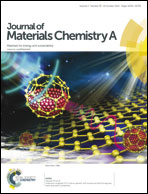High areal and volumetric capacity sustainable all-polymer paper-based supercapacitors†
Abstract
All-polymer paper-based electrodes with a thickness up to hundreds of micrometers (e.g. 290 μm), large active mass loadings (>20 mg cm−2) and relatively high densities (1.23 g cm−3) can be straightforwardly obtained from pristine low-cost polypyrrole–cellulose composites by decreasing the porosity of the material via space engineering. By straightforward compression of the composites, compact capacitive storage devices with improved space utilization are obtained without significantly compromising the electrochemical performance of the devices. This indicates that the compression unlike other methods previously used to vary the porosity of these composites does not affect the distribution of the mesopores which mainly determines the electrochemical performance of the material. When used to manufacture green supercapacitors comprising entirely of environmentally friendly materials, the freestanding and binder-free porous yet dense electrodes yield an areal capacitance of 5.66 F cm−2, a device volumetric energy density of 3.7 W h L−1 (based on the volume of the entire device) and the largest volumetric electrode capacitance of 236 F cm−3 so far reported for conducting polymer-based electrodes. The presented results for symmetric supercapacitors containing aqueous electrolytes represent significant progress in the development of inexpensive and environmentally friendly high-performance paper-based energy storage devices.


 Please wait while we load your content...
Please wait while we load your content...